Lubiąż Monastery - a gigantic Cistercian abbey, a barrel of tar and three tablespoons of honey
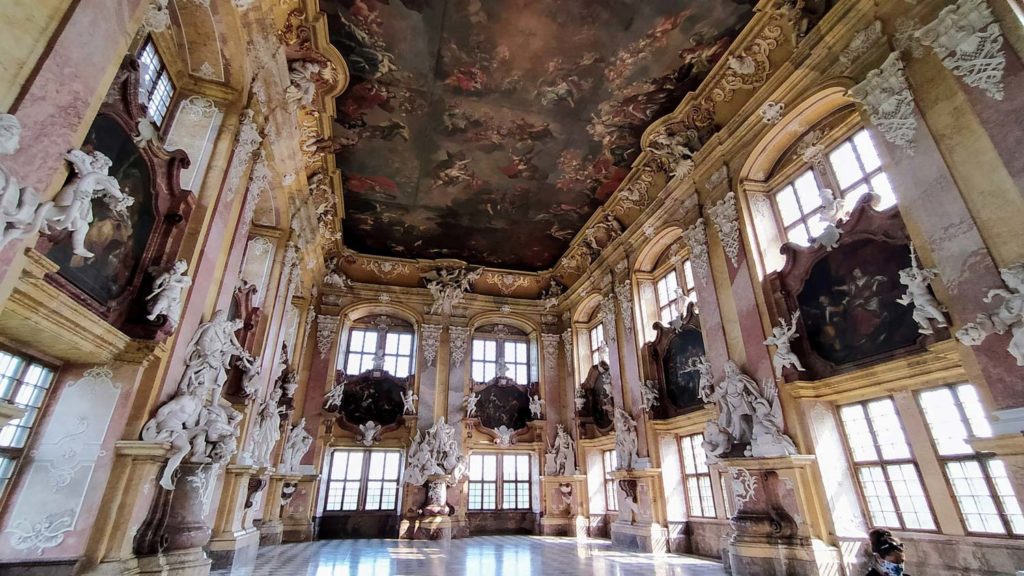
Tar and honey
The abbey in Lubiąż is like a barrel of tar with a spoon of honey. Yes Yes! I was not wrong! Not the other way around. Exactly as I wrote. A barrel of bitter tar and a tablespoon of honey. Why?
Imagine a building, a really huge monastic structure.
How huge?
Almost three times larger than Wawel. The second largest sacred building in the world and the largest Cistercian facility in the world. The abbey in Lubiąż is unique in this respect in the world!
The enormous facade, 223 meters long, has over 600 eyes. When I saw the abbey live, I just muttered under my breath: oh gosh!
I craned my neck to see the end of the facade. The building went on forever. Immediately I thought there would be a problem with taking a satisfactory photo. It is difficult to show the size of the abbey buildings in the photograph. Well, as I thought at first, it happened. The photos do not reflect the scale of this building.
The facility is really huge. Unfortunately, a glance is enough to see that it is in a state that can be called "the state adjacent to the ruin." Deep damage is immediately apparent. Once inside, this impression only deepens. The scale of the damage is truly alarming. Rooms brutally boarded up, walls partially stripped of plaster, long-term stains on the walls.
The installations were forcibly torn from the walls, and only deep holes in the walls - like fresh, ungraded scars - testify that pipes or cables used to run here. Depressing. A mighty building is like a mighty barrel of tar. It tastes bitter in your mouth looking at it all. The eyes are bleeding, the heart is bleeding, but there is also a little honey. The three renovated rooms are like three teaspoons of honey with such sweetness that they compensate for any bitterness: the Abbot's Dining Room, the Refectory and the Prince's Hall.
Are the three renovated rooms in the entire facility able to compensate for the bitterness of the ruins of several hundred remaining? If I were to answer this question blindly, I would say NO with confidence, but ... when I saw these three halls live, my knees buckled. I was speechless. I forgot for a moment all the devastation I had regretted so far. I only felt sweetness. It was hard to believe the eyes. It was all the more difficult as illusion is one of the techniques that was used to decorate the rooms ... (I will write about it a bit below, however).
Again, I was caught up in the photographer's dilemmas, this time of a different nature. My fingers tingled at the very thought of the beauty of the photos here in a moment.
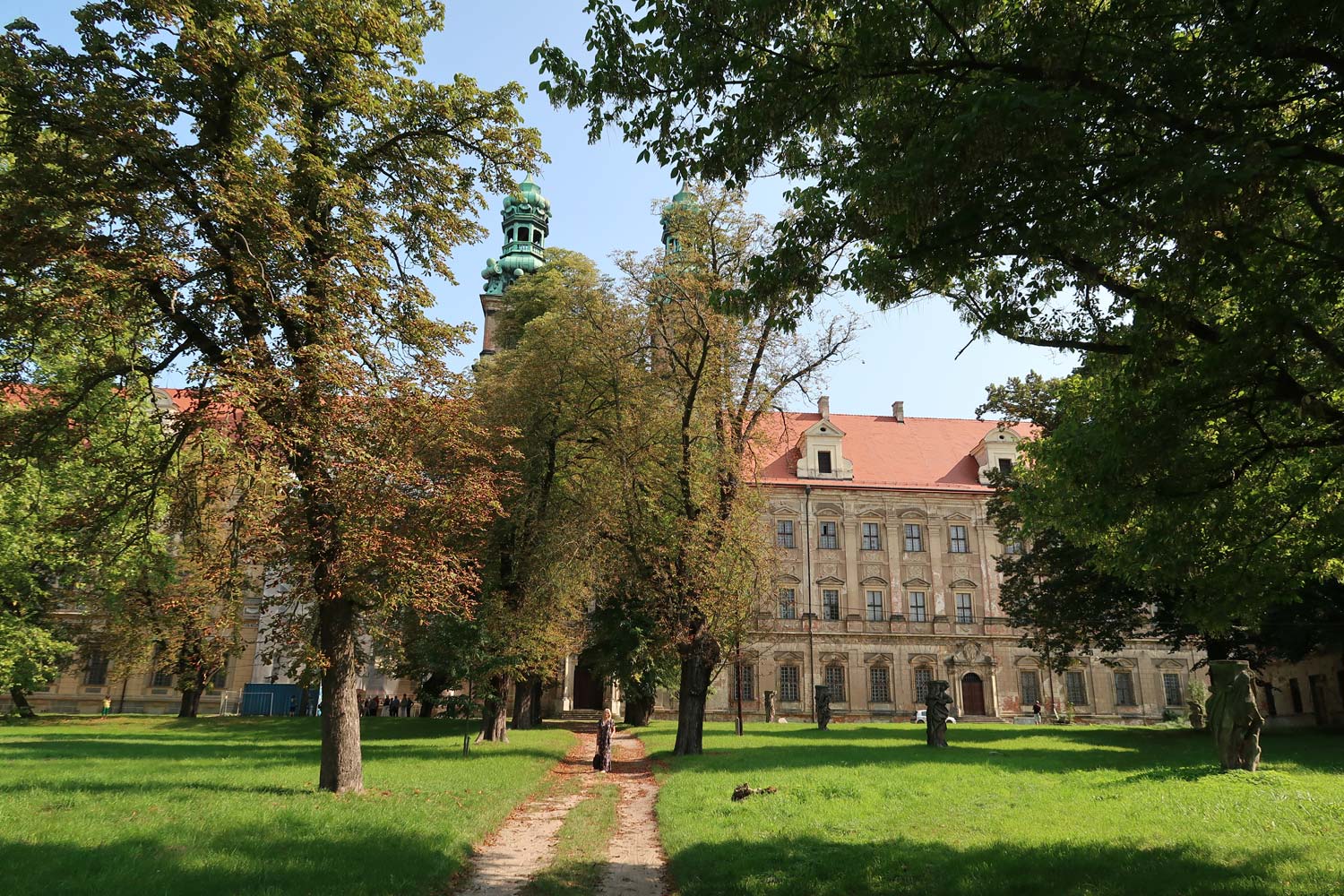
The largest Cistercian abbey in the world in the middle of nowhere
As I mentioned at the beginning, the abbey in Lubiąż is the second largest sacred building in the world, and also the largest Cistercian facility in the world. When you come here to see it with your own eyes, no doubt when you get there, you will no doubt ask yourself: How did something like this come about in the middle of nowhere?
I got out of the car, straightened my back, looked around and asked myself exactly that. The answer was so obvious that it was surprising.
River of money
The abbey was built at the crossing of two rivers. One of them is visible on the map at first glance: it is the Oder. A second river once crossed the Oder: the river of money. The river of money was generated by the trade route running there (leading from the west to the east), in fact one of the oldest crossings across the Oder, connecting Legnica with Wielkopolska.
When in the fall of 1163 Bolesław I Wysoki (grandson of Bolesław Krzywousty) returned to Silesia from a 17-year exile as a result of happy changes in political systems, several Cistercians were in his retinue. They came from Pforta nad Saala in Thuringia.
Development of the abbey
Bolesław Wysoki handed over to the arriving Cistercians the town of Lubiąż (which was already considered very old at that time), the Odra crossing and the market, and the Church of St. John. He approved the posting in 1175 with an appropriate document, a fragment of which you can see below.
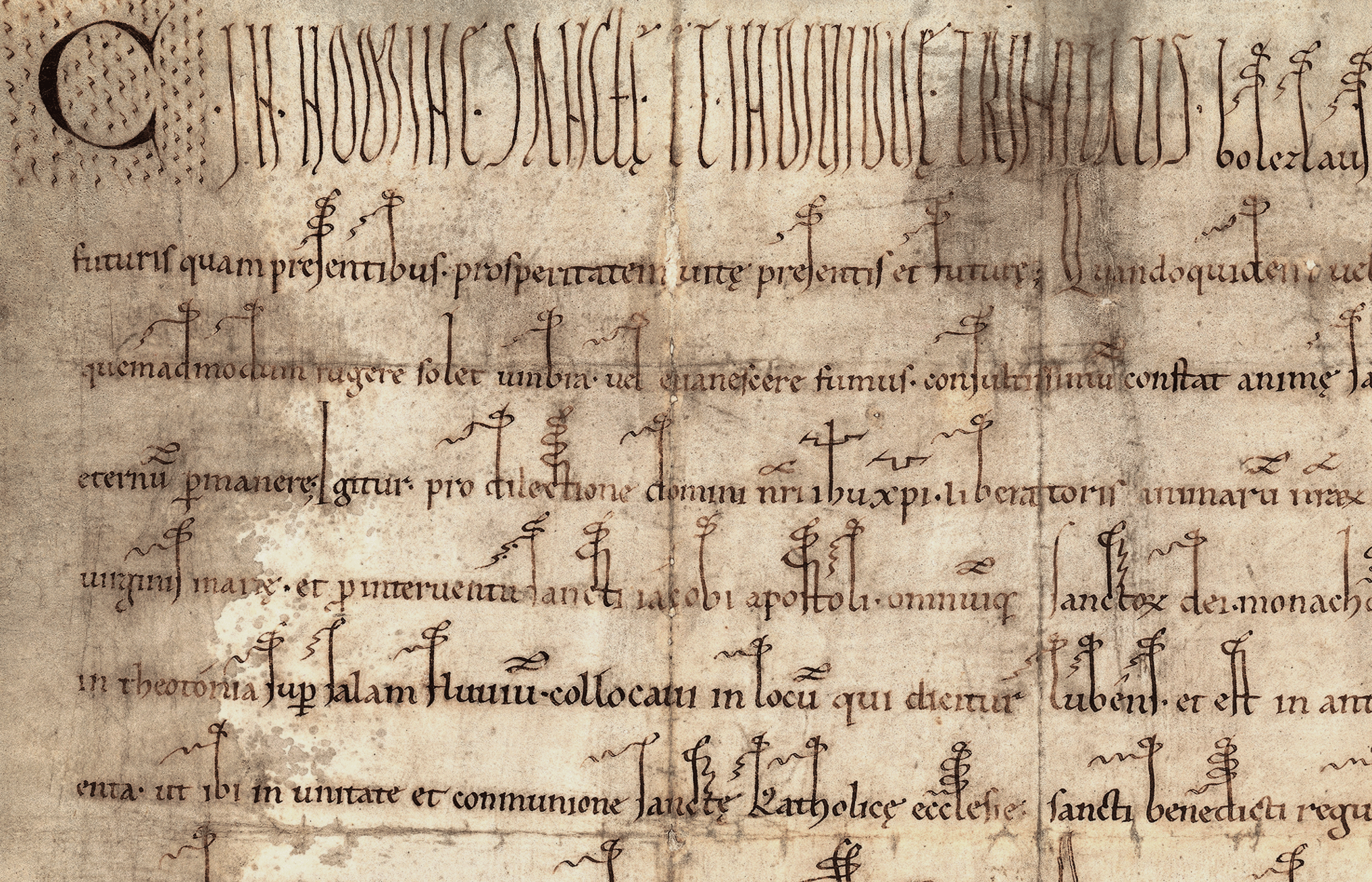
source: wikipedia.pl
There were more grants. In a short time the Cistercians gained new areas, markets, taverns, mills, farms, fishing rights ... which, combined with their diligence, commercial sense and skills, resulted in rapid development and expansion into new areas. They established vineyards, cultivated orchards, traded in salt and herring (they even gained the right to trade in herring duty-free), and built new passages. The estate grew rapidly.
Already in the first half of the 1222th century, the Cistercians could boast of several extensive estates constituting branches of their headquarters: in Mogiła near Kraków (1227), in Henryków (1249), in Kamieniec Ząbkowicki (XNUMX). They also took over the care of the Cistercian convent in Trzebnica.
The monastery at the abbey has become an important place for the development of culture and literature. Some of the most important XNUMXth-XNUMXth century texts were written here: Chronicle of Polish Princes, Annals of Lubiąskie and Catalog of Wrocław Bishops.
After the death of Bolesław I the High, his body was placed in the crypt of the abbey. Later, five more Piast rulers were buried here.
Ups and downs
The abbey continued to grow and develop for almost 160 years.
However, the further history of the abbey was not easy. It was a constant process of falling into ruin and rebuilding, sliding down into the abyss of destruction and regaining radiance.
Fall
The first collapse was due to religious wars fought in Bohemia (1419–1436), commonly known as the Hussite wars. They spread so wide that they even reached Lubiąż. The monastery and church were burned down. Over the next 60 years, the abbey falls into deeper and deeper ruins.
Rise
At the end of the 1492th century, the abbey is rebuilt, but then comes XNUMX.
Fall
In 1492 a strange situation occurs. There is a sharp conflict within the convent between Polish and German monks. The conflict is so strong that ... it ends with the expulsion of all monks and the seizure of all buildings by secular authorities. For the following years, the abbey serves as a starting point for hunting 🙂
Rise
In 1498, the monks return to the abbey and (probably a little calmer and reconciled) go to work. They conduct thorough, extensive work to restore the damage caused during the Hussite wars and subsequent years of neglect. The reconstruction lasts 12 years, until 1510. At that time, additional fortifications were also built to provide the abbey with greater protection.
Fall
Calm doesn't last long. October 31, 1517 arrives. Then Martin Luther announces and hangs his 95 theses on the door of the castle church in Wittenberg. The Reformation begins. The abbey is radically losing its importance, losing significant influence and becoming poorer. The malaise lasts over 100 years, until the Thirty Years' War.
In 1632 Lubiąż was plundered by the Saxons, and in 1639 it was taken over by the Swedes. In 1642, the Swedish general Duwal, stationed in Lubiąż, ordered the collection of the library and part of the archive to be transported to the then heavily fortified Szczecin, where they were burnt down by lightning several years later.
Rise
Fortunately, every war ends sometime. One year after the end of the Thirty Years' War, in 1649, the then abbot Arnold Freiberg put into effect his reforms. He creates strong and stable financial foundations (the results of his work will be available to the next few abbots). After 100 years of apathy, almost 100 years of prosperity begin.
The style of the entire object gradually changes. The baroque reigns in Lubiąż, in its richest form to the limit.
During this time, new buildings were built: a huge abbot's palace, a monastery, a brewery, a bakery, a hospital and many farm buildings. The abbots' palace and the monastery, which were built at that time, combined with the church formed a sacred complex, known today for its record size.
Michał Willman arrives at the abbot's invitation. An exceptionally talented artist, who deservedly bears the nickname of the Silesian Rembrandt. He certainly does not suspect yet that Lubiąż will become his home for the next 43 years, until his death, and that his life's work will be work related to Lubiąż.
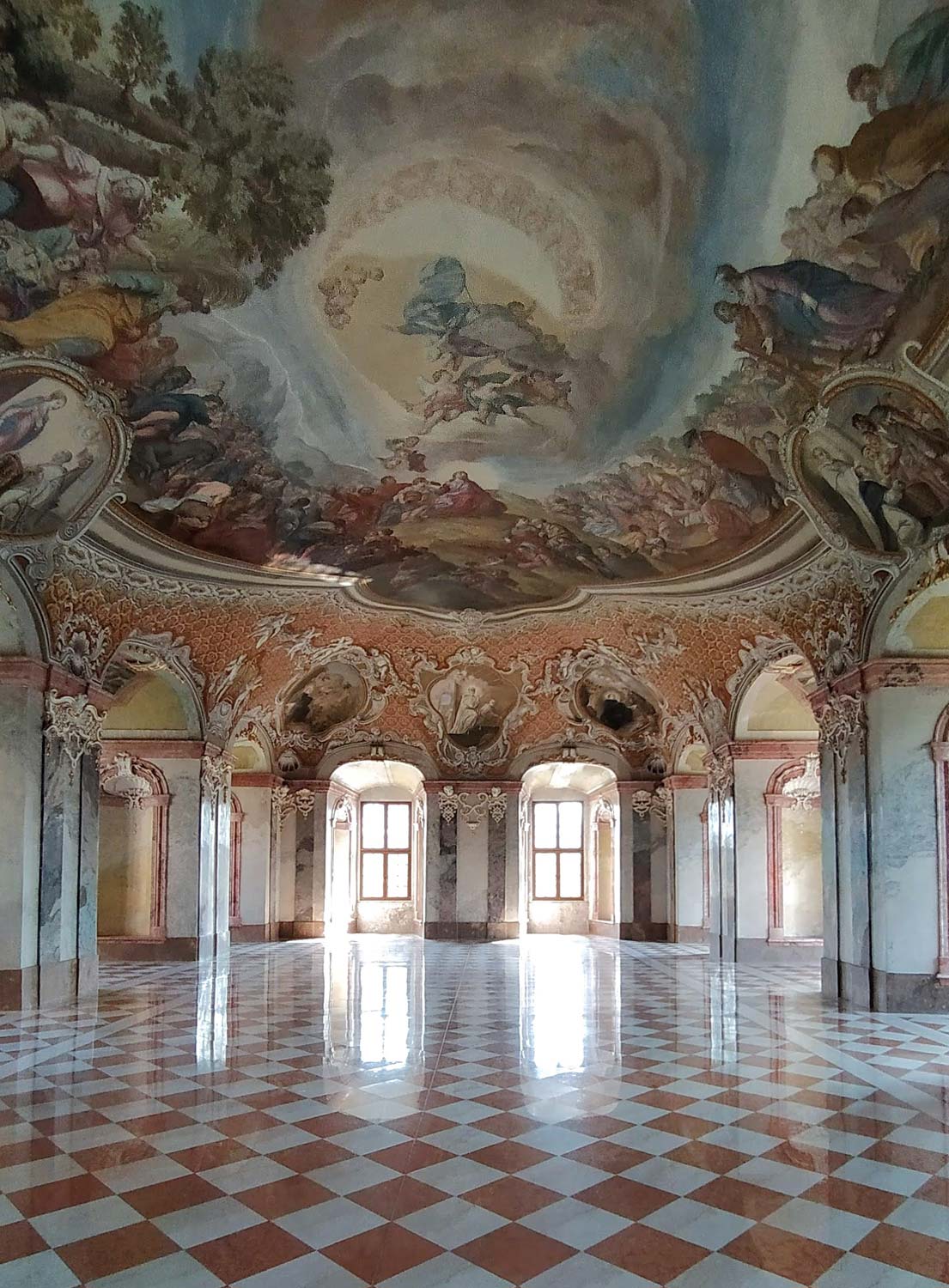
Fall
The change came suddenly in 1740. The King of Prussia, taking advantage of the political turmoil, decided to attack and take over Silesia. Suddenly, the abbey in Lubiąż was under the Prussian protectorate hostile to the church.
To begin with, the King of Prussia imposed a gigantic contribution on the abbey: 200 thalers. Even such a wealthy abbey was unable to pay off such a burden. The king, in his generosity, therefore reduced the fee by half.
Seventeen years later, the Prussian king forced the abbey to grant him an additional 80 thalers of compulsory loans.
Three years later (1760), the Austrians camped nearby forced the abbey to pay 2,3 thousand thalers, and a year later, when the Prussians were stationed at the abbey, it cost the monastery another 77 thalers.
The debts of the abbey continued to increase.
Final collapse
When it seemed that it couldn't be worse, the Prussian king decided to finish off the weakened enemy. On November 21, 1810, he issued an appropriate regulation, liquidated the abbey and appropriated its property, transforming it into secular goods. The abbey in Lubiąż ceased to exist after 650 years.
Fifty-nine villages, thirty-two farms and several manufactories and brickyards became the property of Frederick William III of Prussia.
Curiosity
By the way, I would like to mention that a year after the liquidation of the abbey in Lubiąż, i.e. in 1811, Frederick William III of Prussia gave the order to destroy the coronation insignia of Polish kings, stolen from the Wawel treasury.
The insignia were melted down into coins.
Over time, the buildings performed new functions. St. Jakub was turned into an arsenal, the monastery farm buildings were transformed into a stud, school and clerks' apartments. The monastery was converted into a psychiatric hospital for patients from aristocratic families
The third bottom of the fall
Unfortunately, the story of the fall does not end there. World War II has come. The Germans organized a factory in the abbey's buildings, which was the most important for them during the war: a weapons factory. Inmates from a forced labor camp worked there.
When it became clear that the war was already lost, the Germans dismantled and took away everything they had managed to take from the abbey. Works of art, valuables, church furnishings (probably stalls).
Together with the war front in 1945, the Russians came to Lubiąż. They completed the work of destruction by searching for the treasures they expected to find here. In search of the insignia of power (scepter, apples, swords) of the Silesian Piasts, they destroyed the coffins, from which they dragged the bodies out, scattering them on the floor. Most of the bodies could not be identified afterwards. It is certain that only the mummy of Michał Willman has been identified.
The Russians reached Lubiąż in a cold winter. They warmed themselves by burning picture frames, furniture, and perhaps stalls, which the Germans did not manage to take away at all. Possible and probable.
After 1945, the monastery operated a hospital for soldiers of the Red Army. The Russians would not leave the abbey until 1948.
From 1950, the building was basically deserted. It served a small part mainly as a storehouse for books and museum collections. It was the perfect target for all sorts of recyclable hunters who have severely destroyed what was left, brutally ripping out anything that could be sold.
Most of the rooms remain in this condition to this day. Passing between the rooms intended for visiting, you go through these rooms.
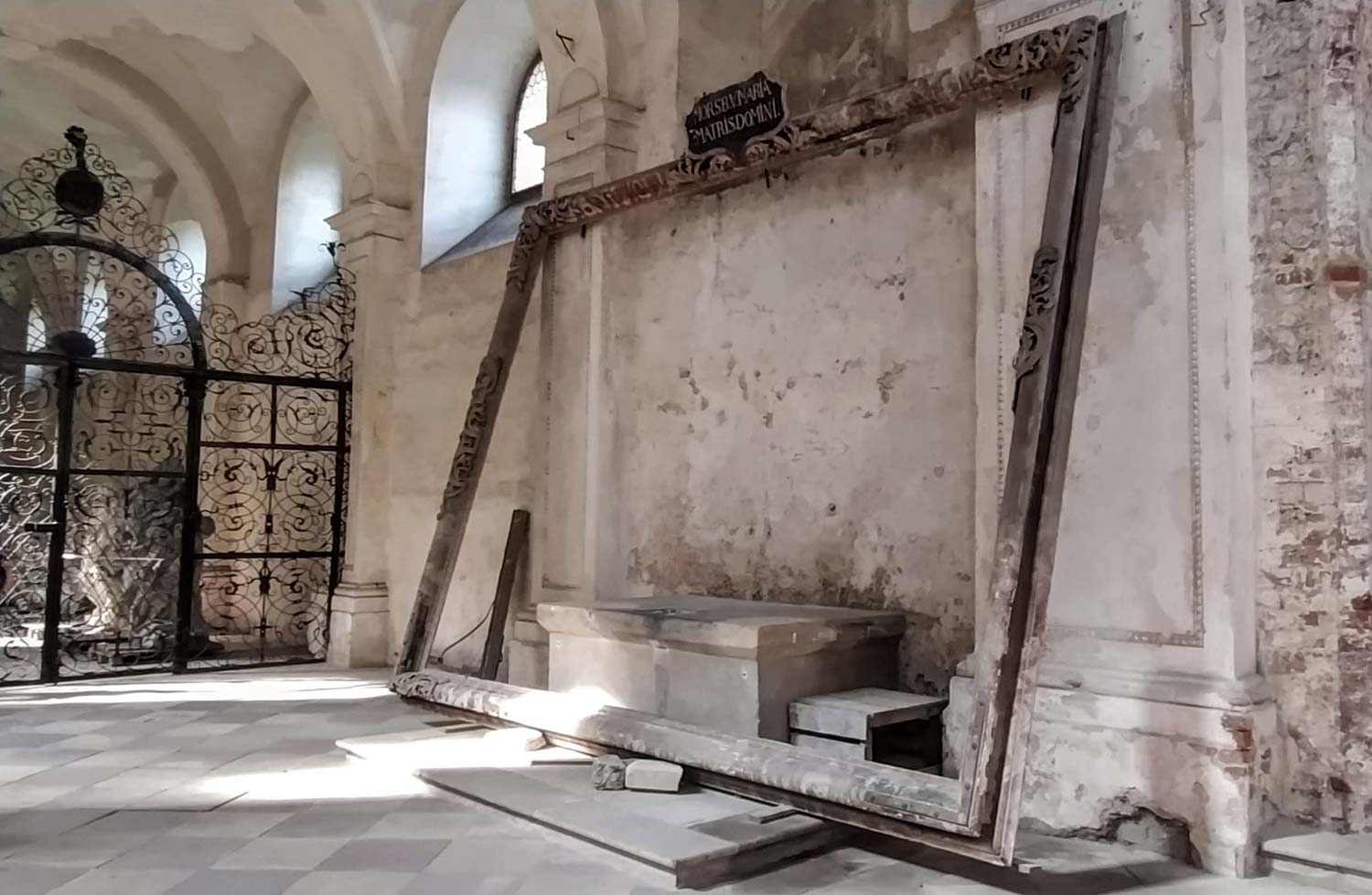
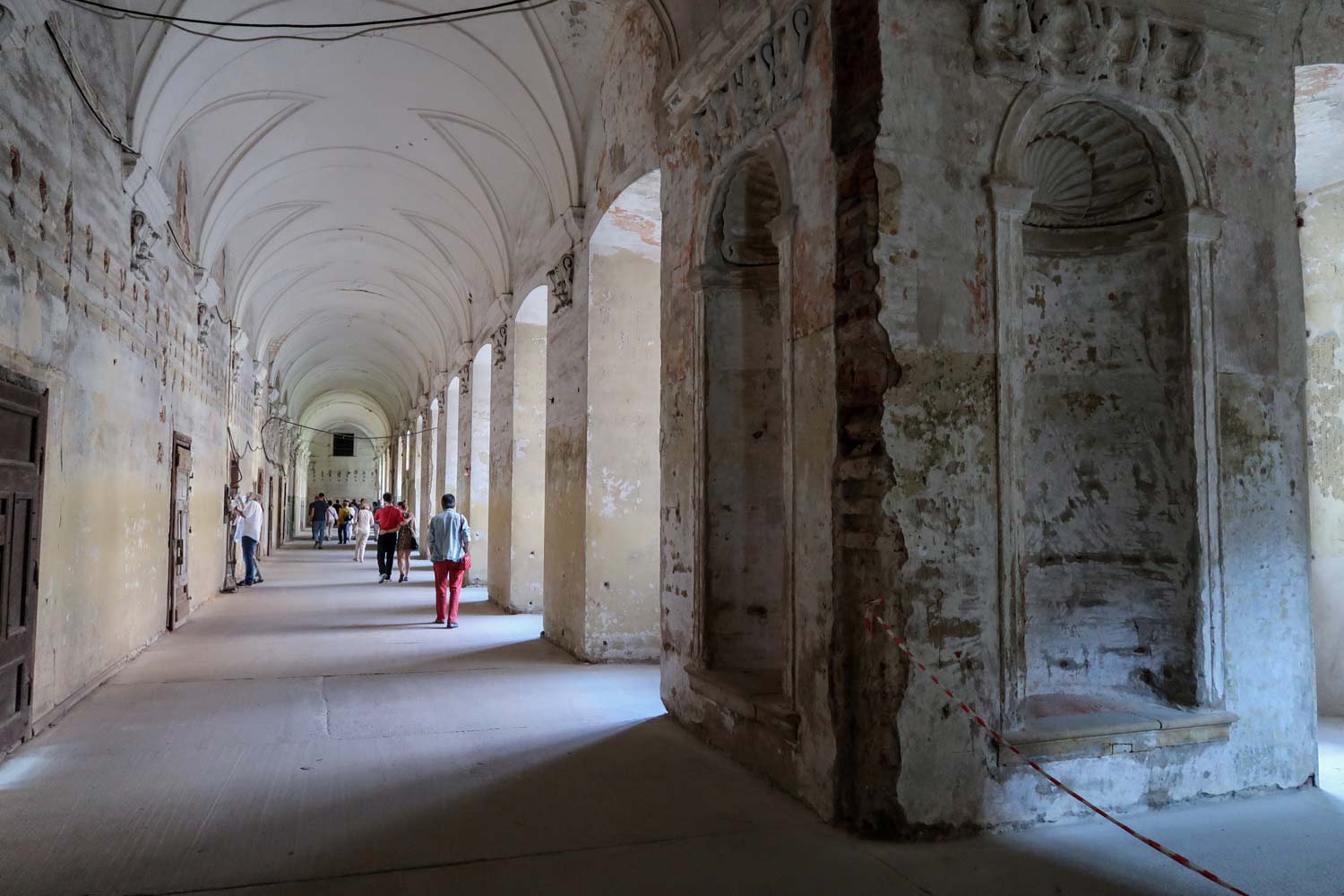
Rise?
Renovation works have been carried out in Lubiąż since 1989. Roofs were replaced over the entire complex. Successive works made it possible to visit the Prince's Hall (2005), the Abbot's refectory (2009) and the summer refectory (2009). The Church of the Blessed Virgin Mary has also been made available for sightseeing unfinished.
Renovation works are still underway on site, but taking into account the scale of the facility, they will last several dozen years.
I sincerely hope that we can witness with our own eyes the beginning of the next ascent, after which no fall will come.
Below is a short drone video found on YouTube, showing the abbey from a bird's eye view:
Visiting the abbey in Lubiąż
Visiting hours
In spring and summer (April 1 to September 30), the abbey can be visited from 9:00 AM to 18.00:XNUMX PM.
During the rest of the year (October 1 to March 31), the tour takes place between 10:00 a.m. and 15:00 p.m.
Sightseeing takes place at full hours. A few minutes before full hour, the ticket office opens and tickets are sold. The facility is so huge that everyone who wants to visit a given hour comes in at once. So there is no fear that there will be no seats for a specific hour.
WARNING!
The cash desk at the abbey does not accept card payments. You can pay only in cash. There is no ATM in the area. The nearest ATM is 2 km away.
About 650 m from the abbey is the Dino shop, where you can withdraw cash when making small purchases (e.g. bottles of water).
We arrived in Lubiąż 15 minutes before the full hour, and since we were here during the covid-19 pandemic, when they were trumpeting everywhere: pay with the card, we didn't have cash. When the ticket office opened five minutes before the tour, it turned out that we could not buy a ticket. Of course, we had no chance to make it to the ATM and back. You had to wait an hour and visit the abbey with another group. We used this time to walk around the green area in front of the abbey.
Ticket prices (in 2020):
- normal PLN 20
- reduced PLN 15
Map of the abbey in Lubiąż
Below is a map with the location of the abbey in Lubiąż. The numbers on the map correspond to the numbers next to the descriptions under the map.
The GPS coordinates of the parking lot to help you get to the place can be found at the bottom of the entry.
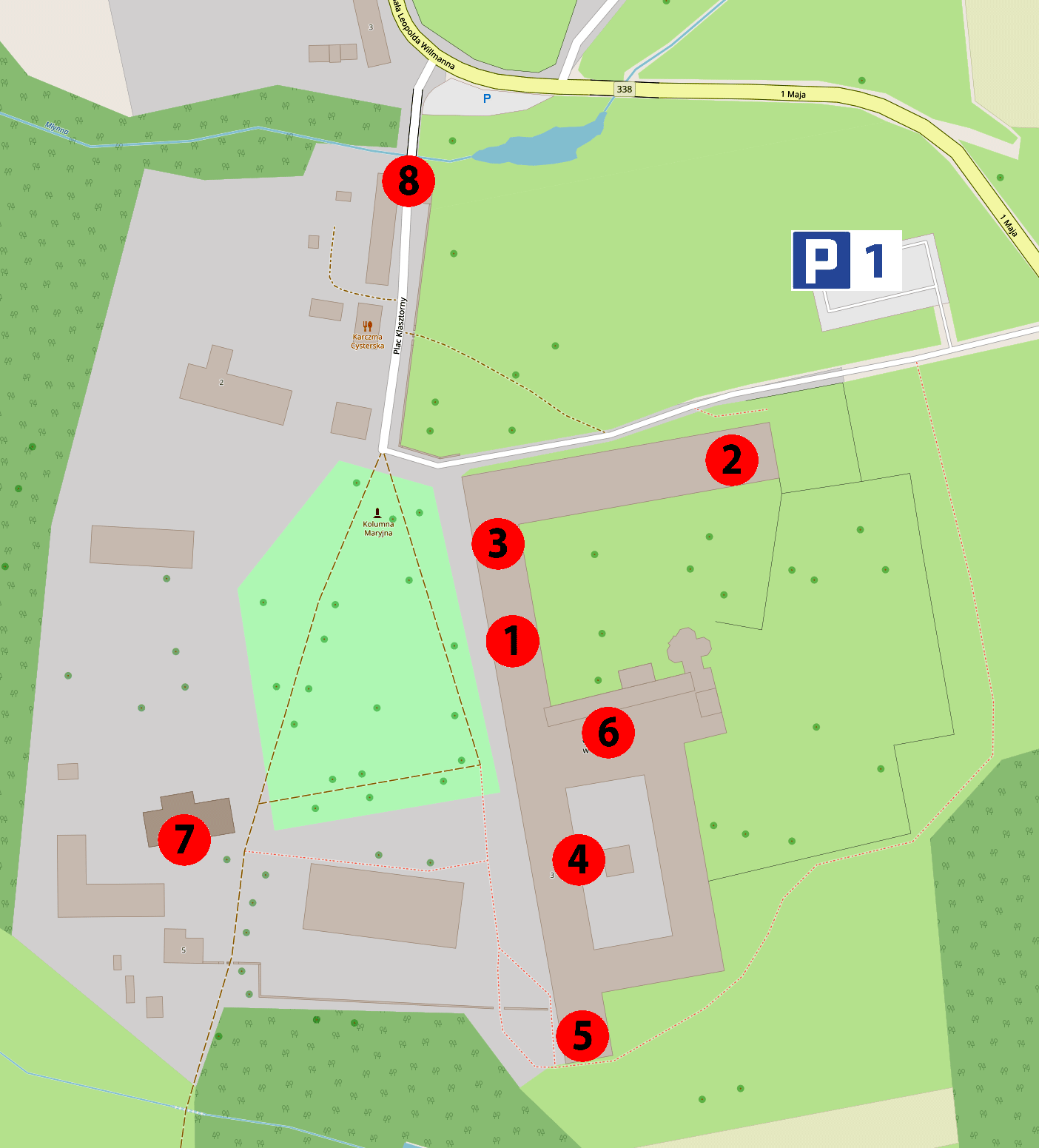
1. Abbots' Palace
The Abbots' Palace is an enormous L-shaped wing of the building that starts on the map where the number 1 marker is and continues through number 3 to number 2.
It was established in the years 1681-1699. There are two rooms open to the public: the Prince's Hall and the Abbot's dining room.
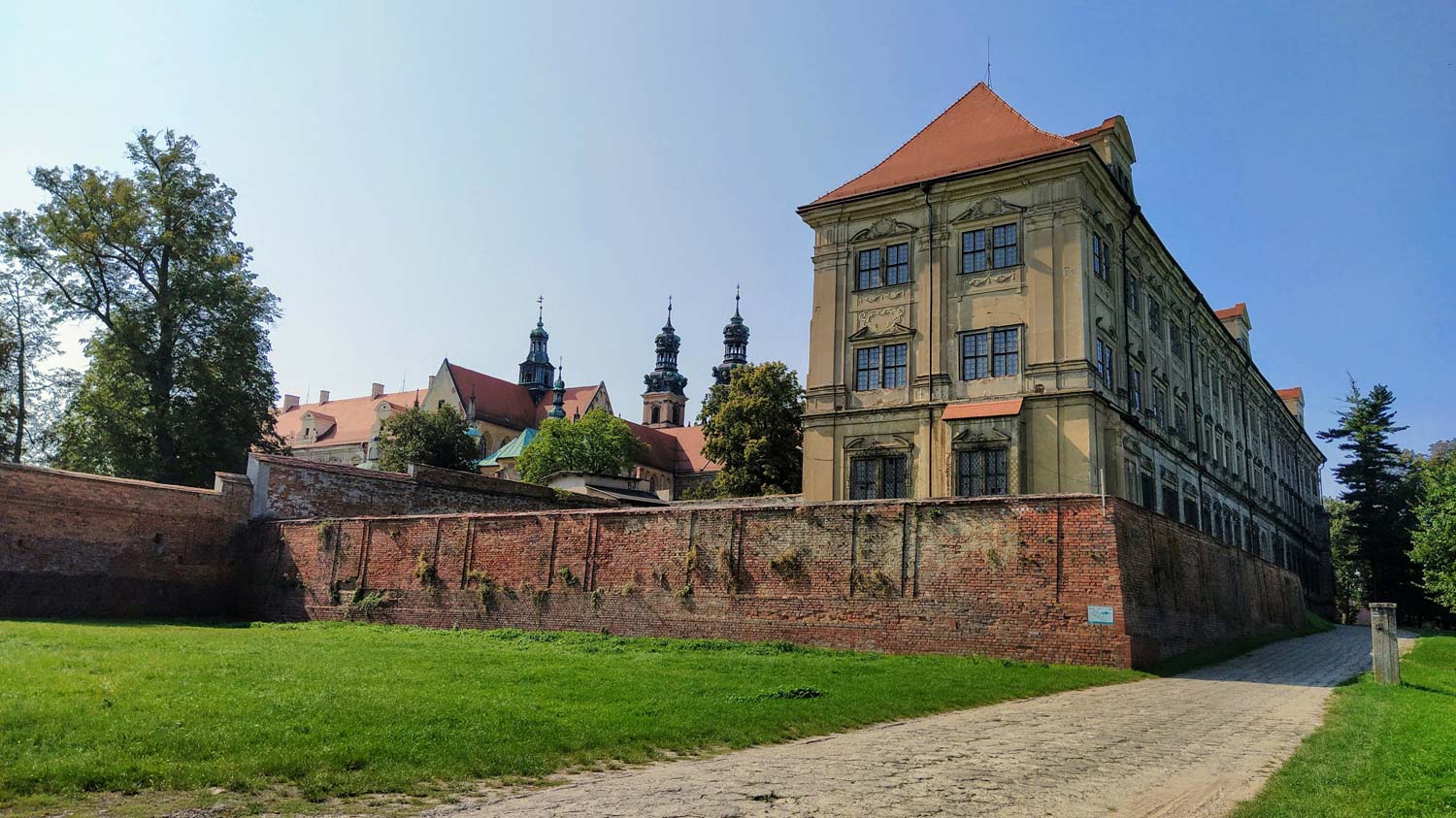
2. The prince's hall
The hall, two storeys high, is unimaginably filled with baroque ornaments, paintings and sculptures. The walls are lined with colored marble.
Any attempt to describe this room in words is doomed to failure. This cannot be imagined. The photos tell a lot more, but even after seeing countless photos, the room is breathtaking when seen live. After getting inside, most people simply remain silent for a long time, trying to embrace the shocking interior. I sincerely recommend.
The room has an area of 420 m2. The painting on the ceiling is not much smaller (about 300 m2) and it is one of the largest paintings in Europe. The author of the paintings is Christian Bentum.
The halls are filled with a dozen or so extraordinary sculptures. Their author is Franciszek Józef Mangoldt (he is also the author of sculptures in the Leopoldina Aula at the University of Wrocław).
The sculptures on one side of the room are figures of the Habsburg emperors, and on the other side are mythological and allegorical figures.
The whole is perfectly complemented by intricate stucco work by Albrecht Provisore.
Ten paintings placed between the windows are dedicated to one person: Empress Elizabeth, wife of Charles VI.
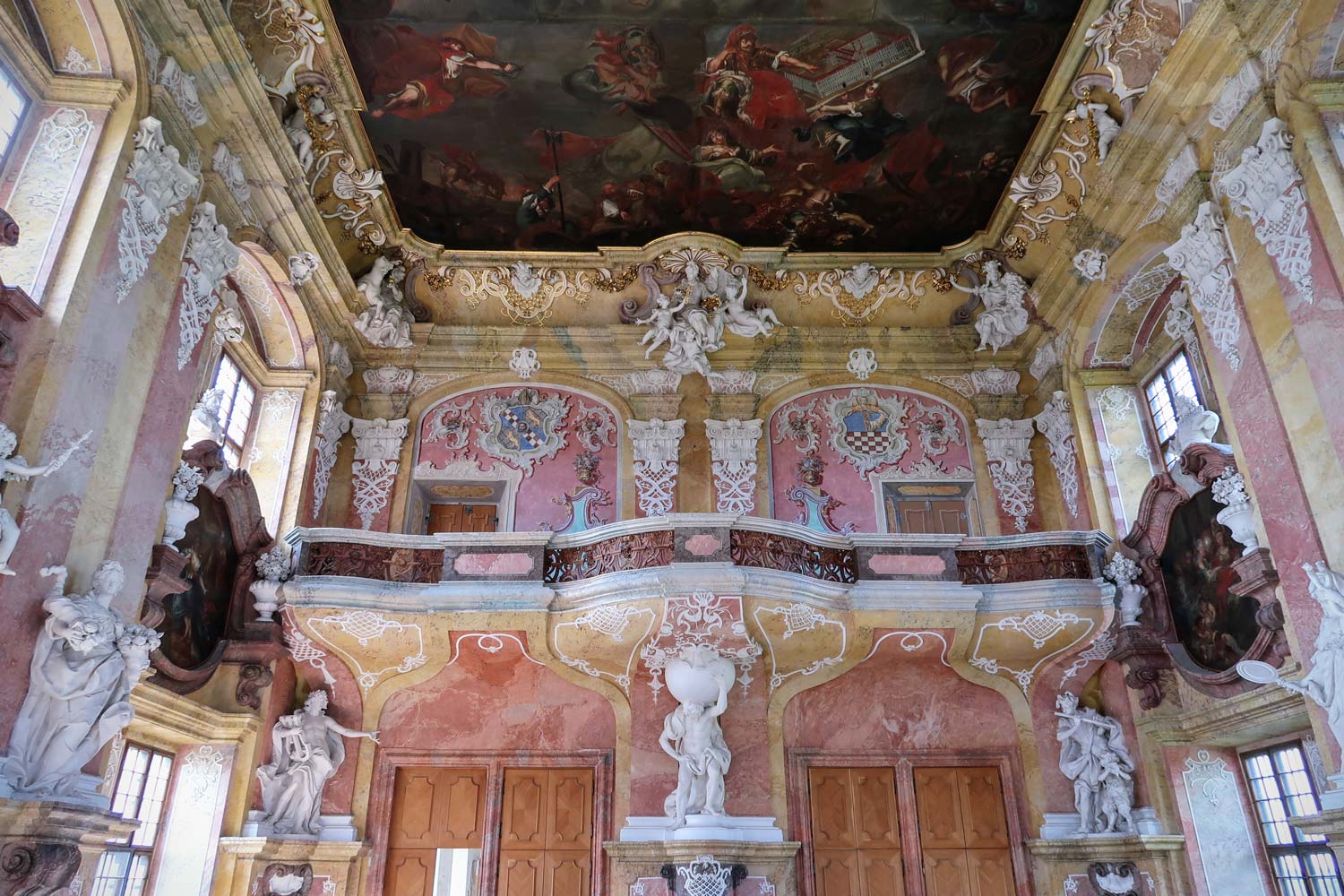
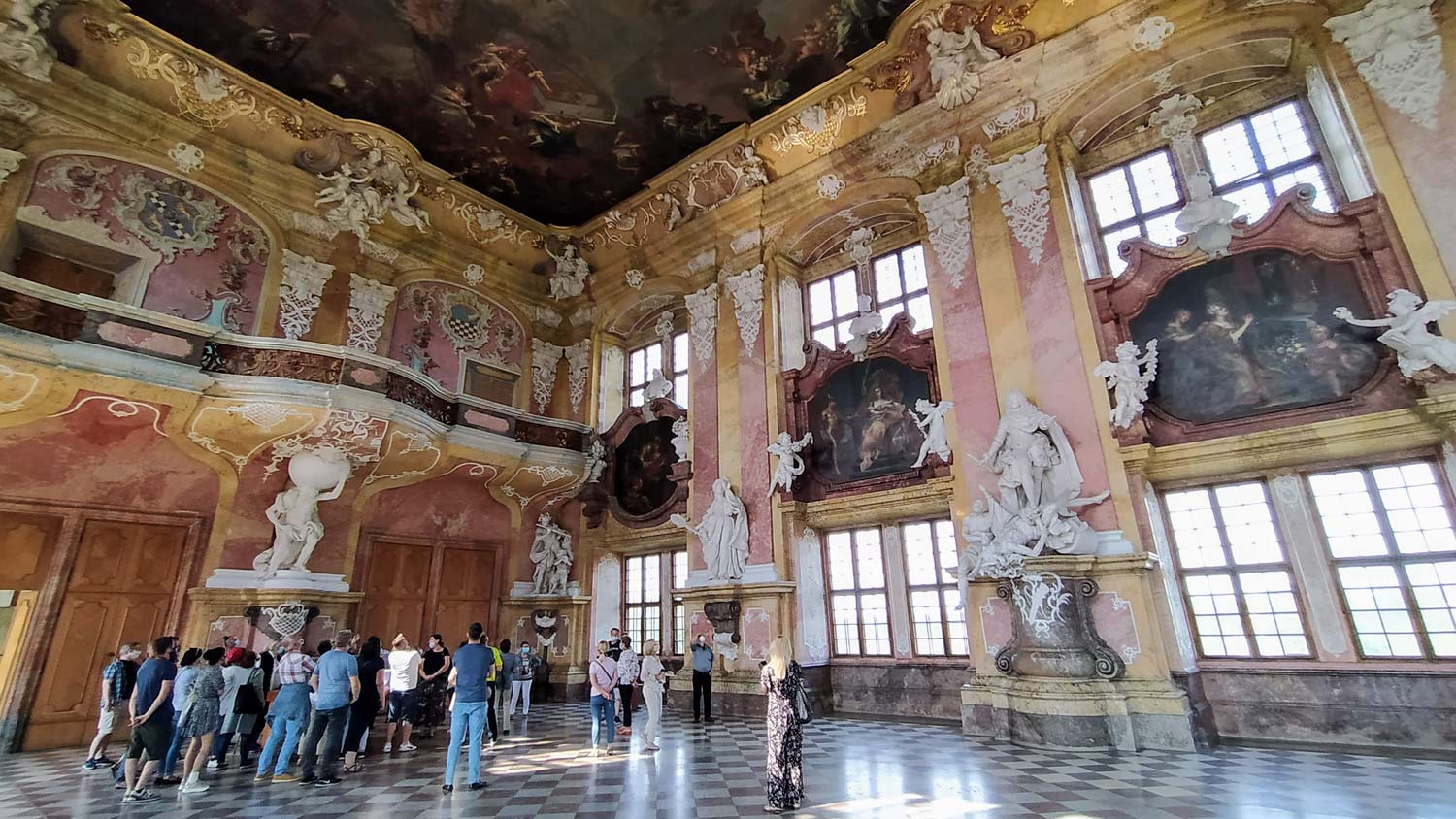
3. Abbot's dining room
The abbot's dining room is located near the cash desk. When others are still buying tickets, you can easily watch it. Going down the corridor from the cash desk, on the left, you will find the entrance to the abbot's dining room.
It is here on the ceiling there is a painting by Michał Willman. He said that it was the first great fresco in his career. The painting should be viewed from the narrow edge of the room. In the painting, the triumphant hero of virtues is suspended between earth and heaven.
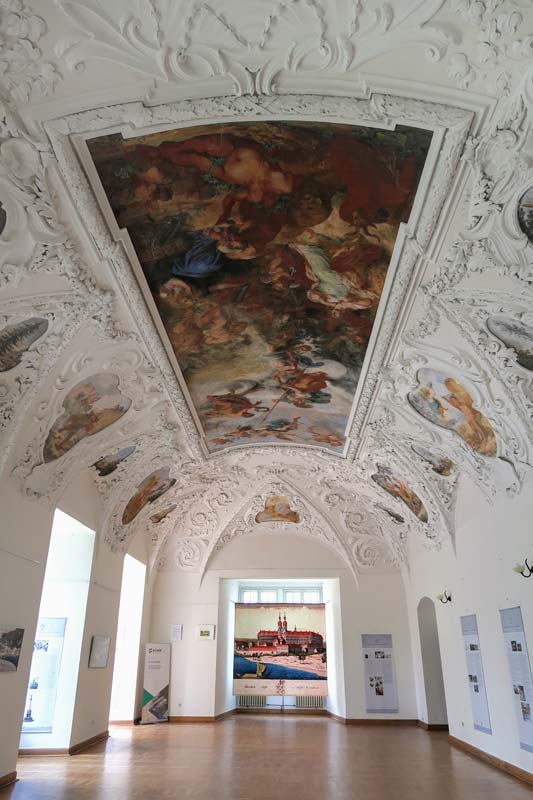
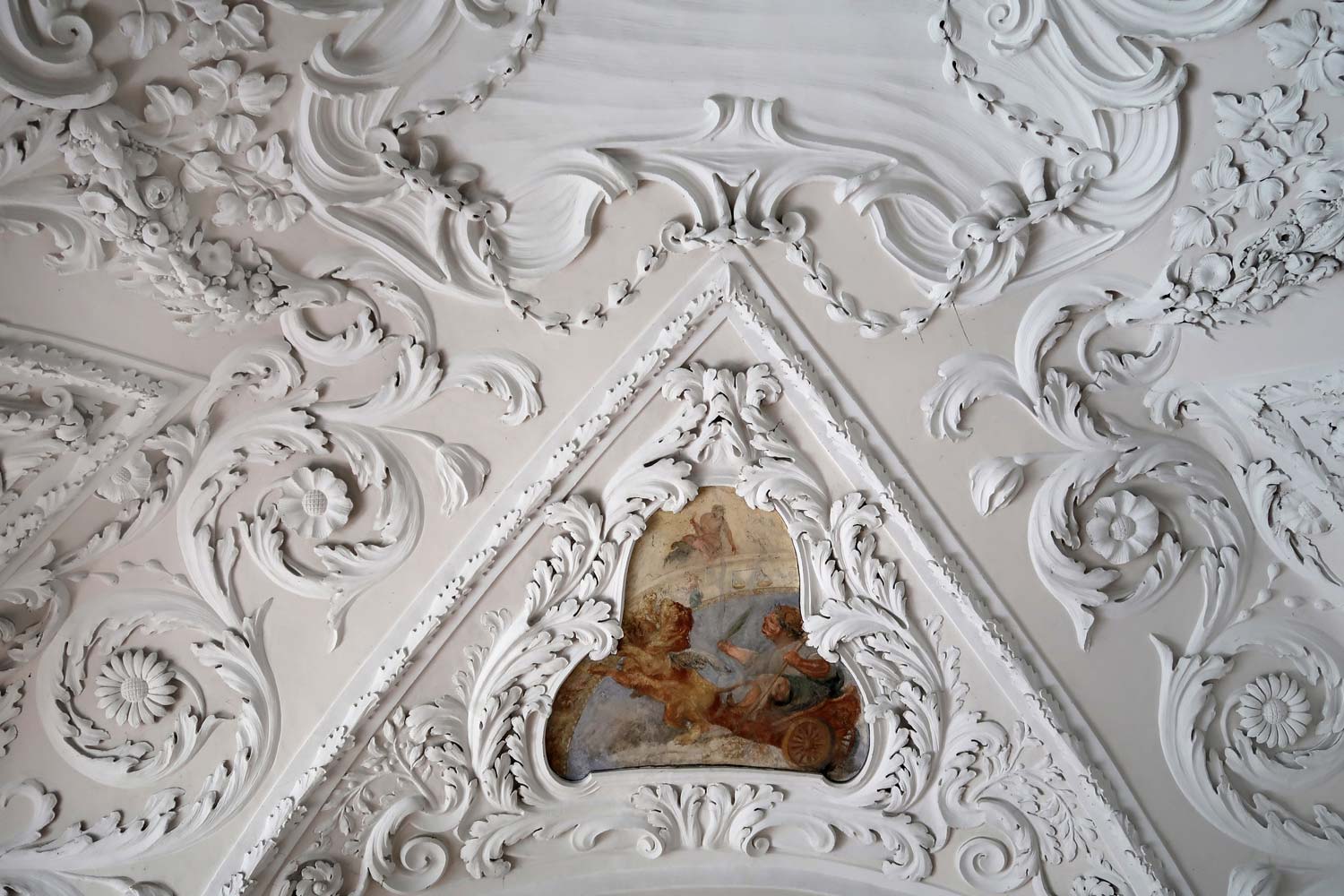
4. Monastery
The monastery is shaped like a rectangular building with a courtyard. It is integrated with the Church of the Blessed Virgin Mary. It was built in the years 1692-1710. There are several dozen living quarters for monks on each floor. Each of the cells has an area of 25 to 50 m2.
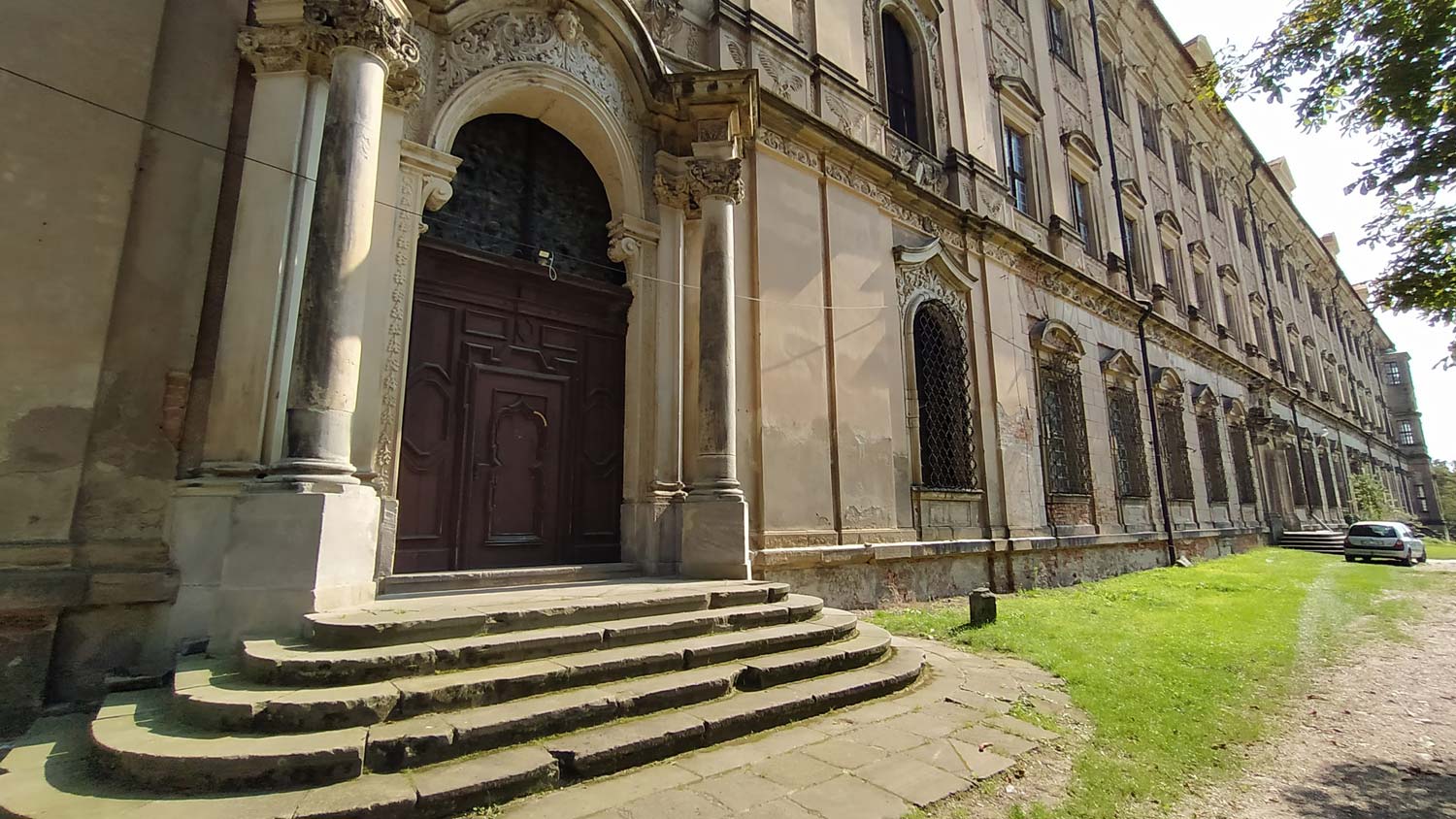
5. Summer refectory
After leaving the princely hall, I thought that nothing would surprise me anymore. Until I found myself in the summer refectory. I was speechless again. The hall is fabulous. Pastel colors, ways of decorating and the art of illusion used in painting make an incredible impression. Once there, take a good look at the walls. What appears to be intricate stucco is not really. The artist made the painting in such a way that it deceives our eyes. He created three-dimensional images that give the impression of plaster decorations. If I hadn't walked right up to the wall and saw that it was really flat, I would never have believed that there is no real stucco in this place.
The author of the paintings is Feliks Scheffler.
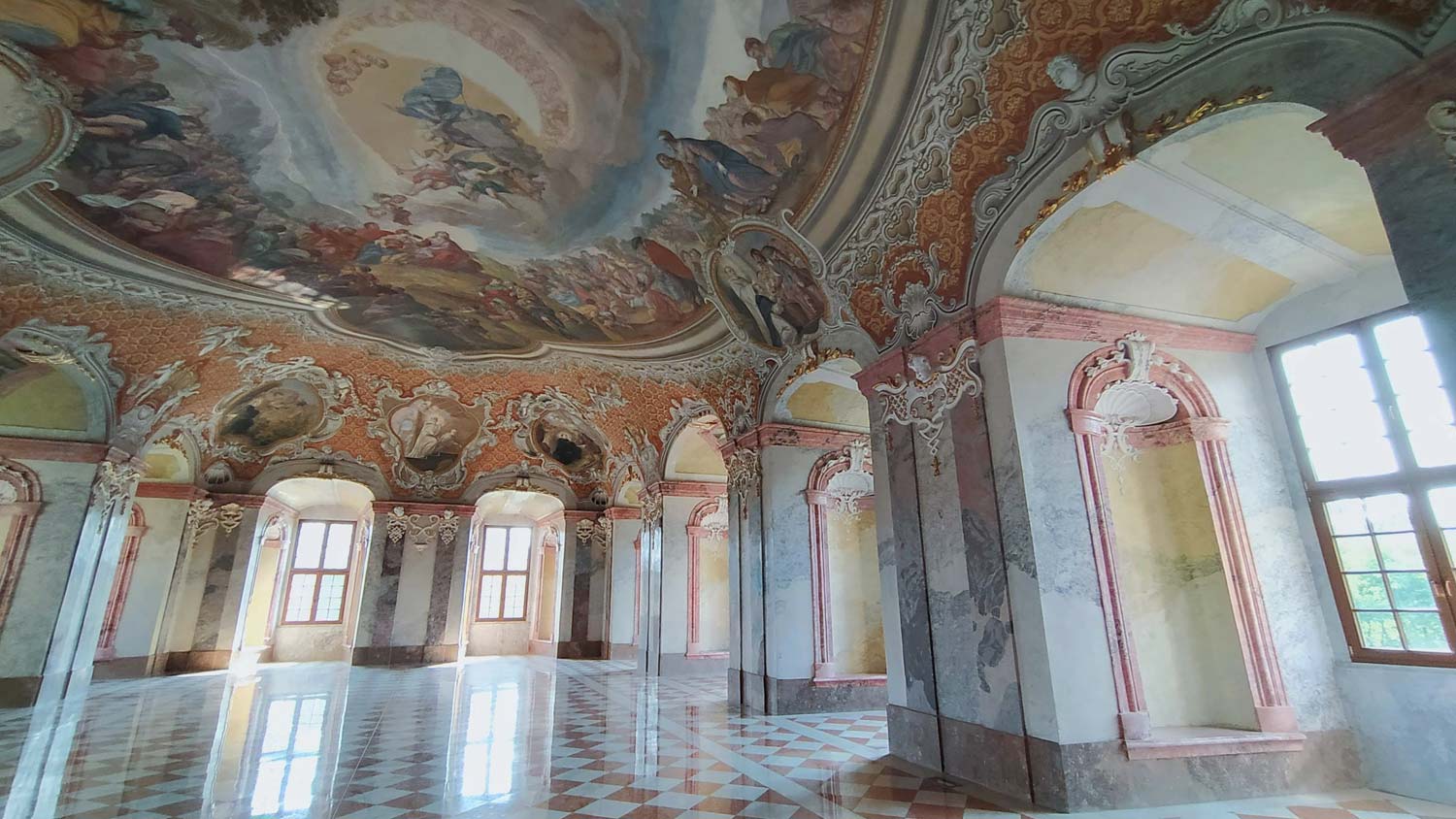
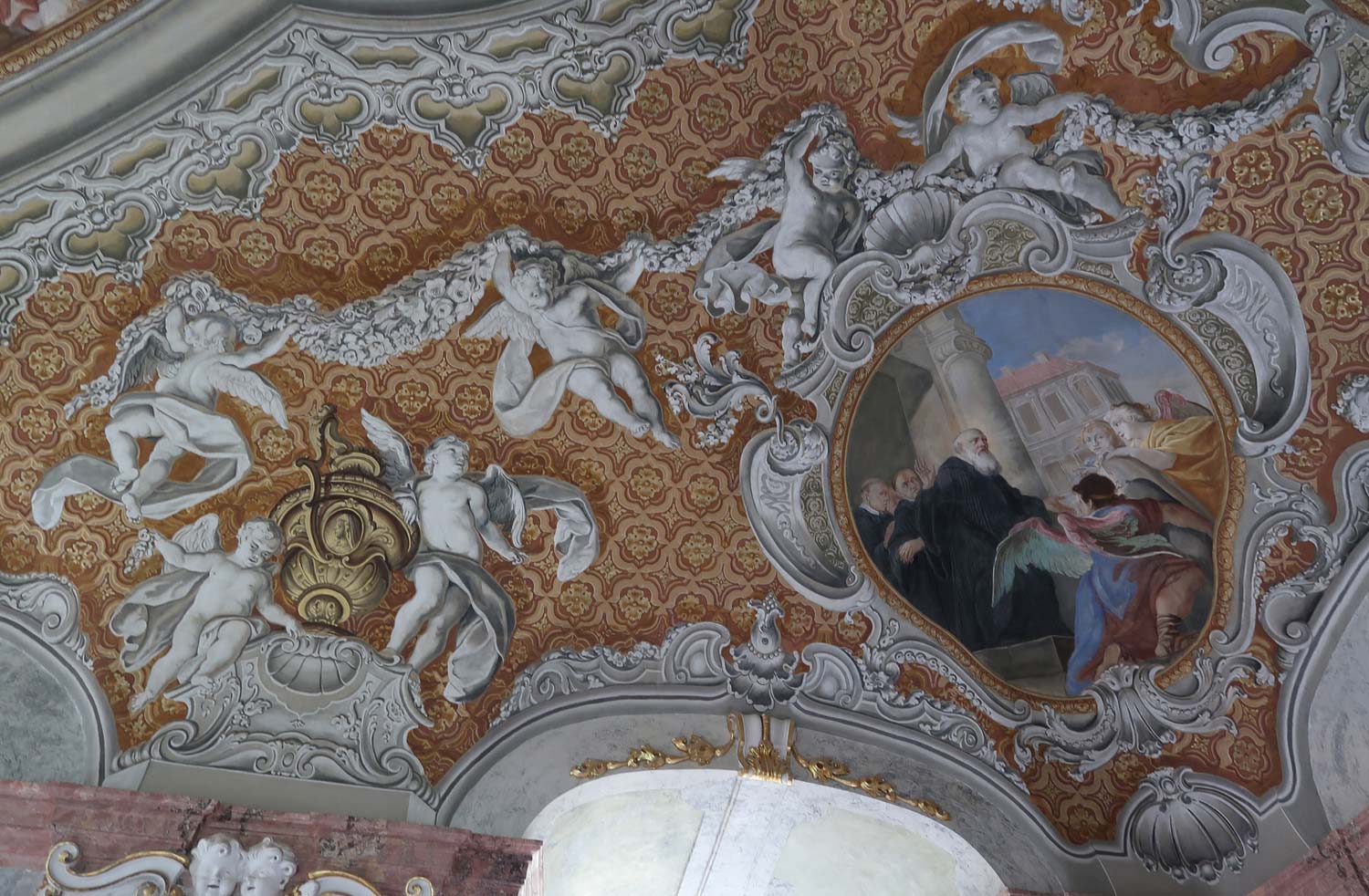
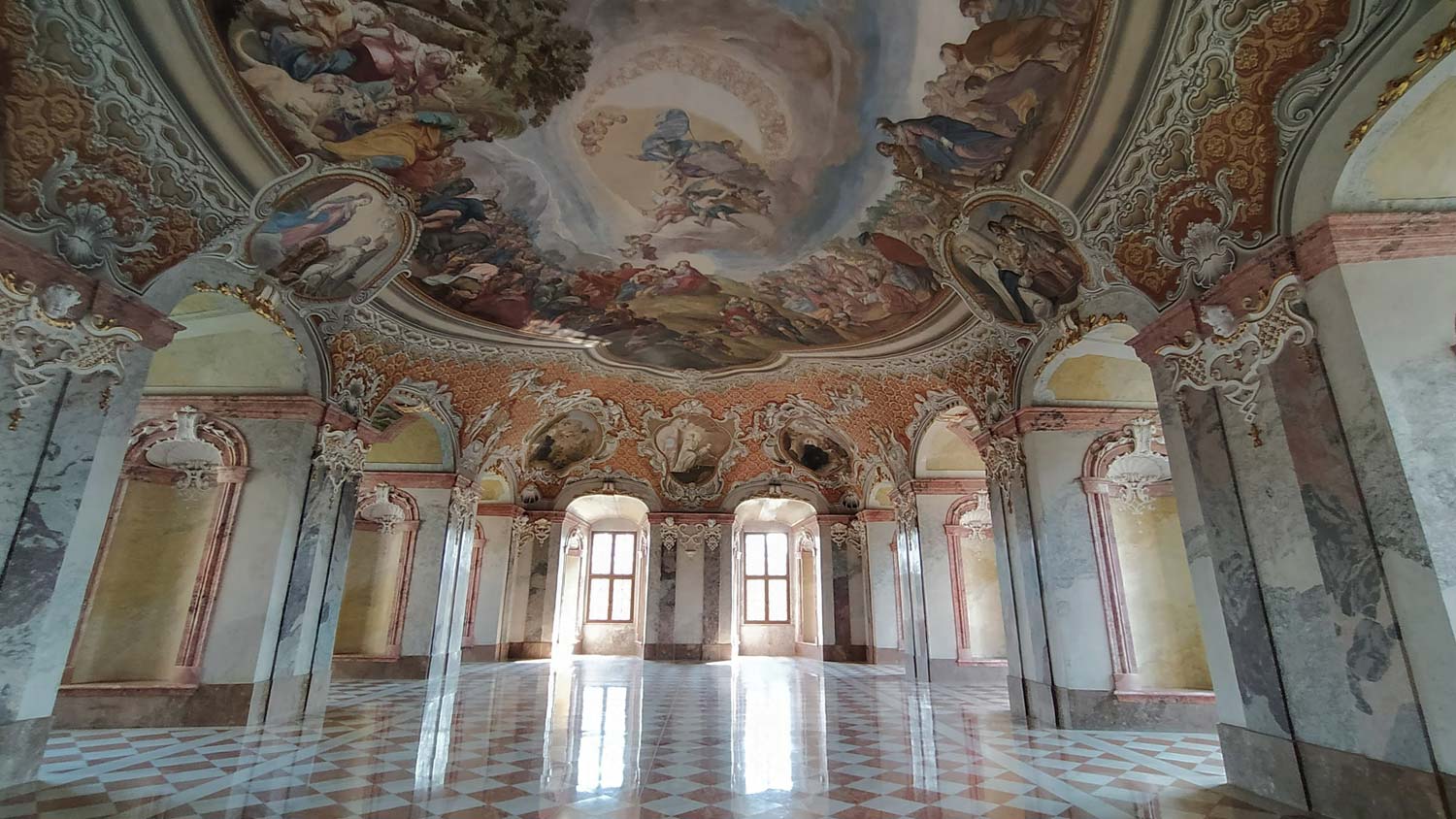
6. Church of the Blessed Virgin Mary
The Church of the Blessed Virgin Mary is an integral part of the main buildings of the abbey. It is structurally integrated into the main façade of the abbey and connected with the rectangular building of the monastery. The interior of the church is not renovated and gives a depressing impression. I've never been to a church like this. Raw walls, peeling plaster… if the walls could be stolen, they probably would have been stolen too.
The church used to be filled with paintings by Michael Willman, including the famous series of gigantic canvases measuring 3 by 4 meters under the common title "The Martyrdom of the Apostles". Most of them were taken away from the church and survived. Twenty-eight of them can be seen in fourteen Warsaw churches, and another three in the National Museum in Warsaw.
In the church there were also beautiful, richly decorated wooden stalls (ie seats placed at the side walls of the chancel, intended mainly for clergy. You can see them in the old photo below, taken before the war.
The stalls were dismantled and taken away by the Germans or burned by the Russians, who burned e.g. church furnishings just kept warm in winter.
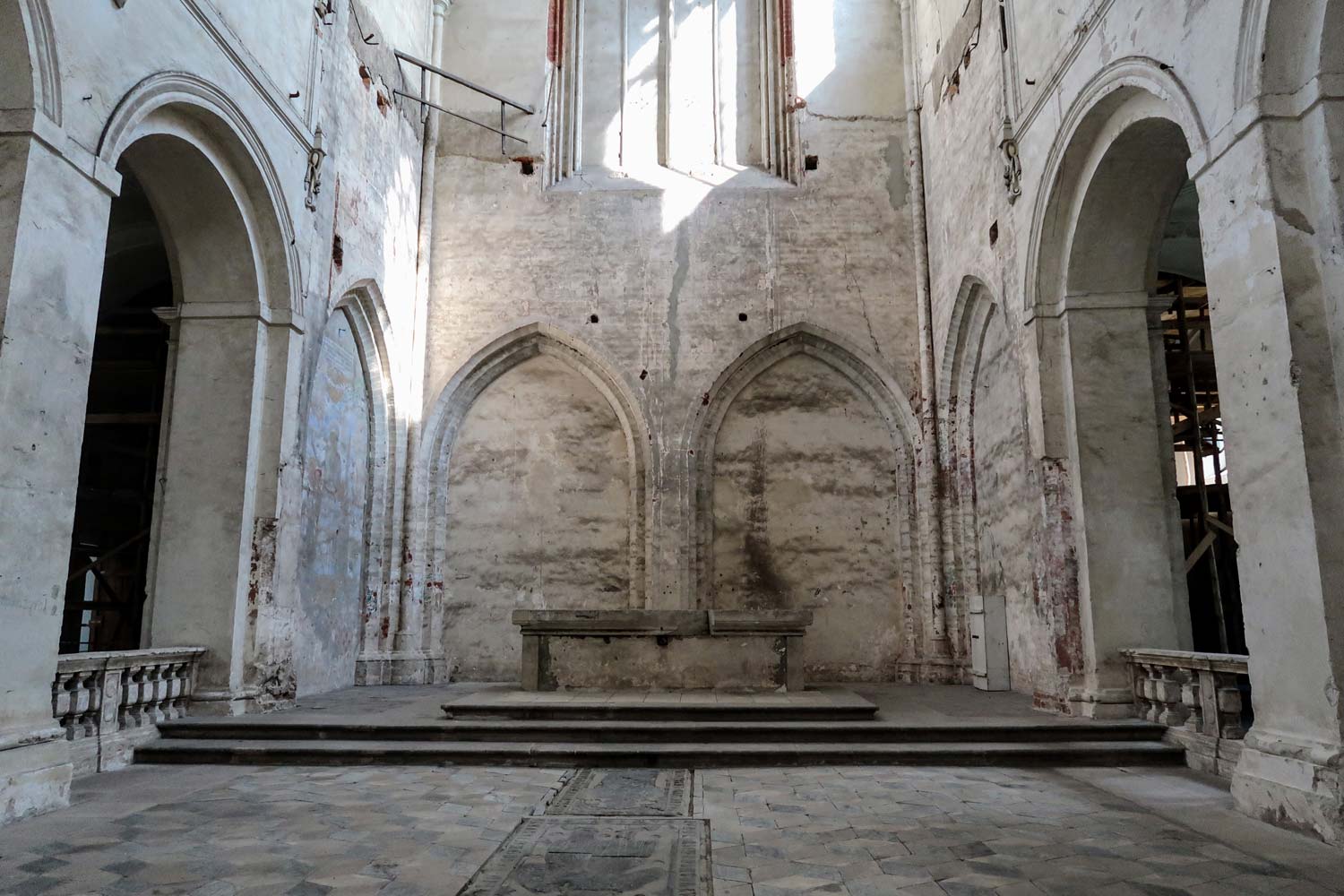
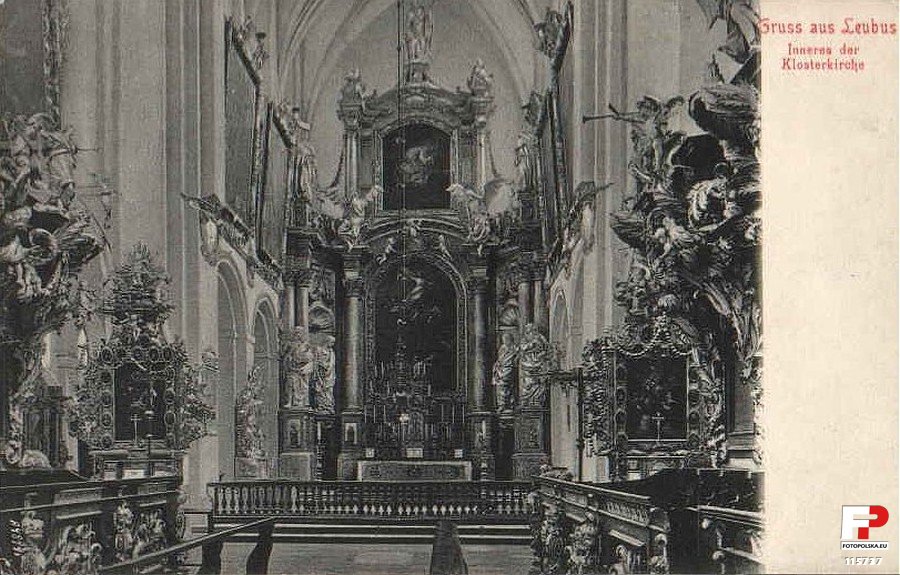
source: fotopolska.eu
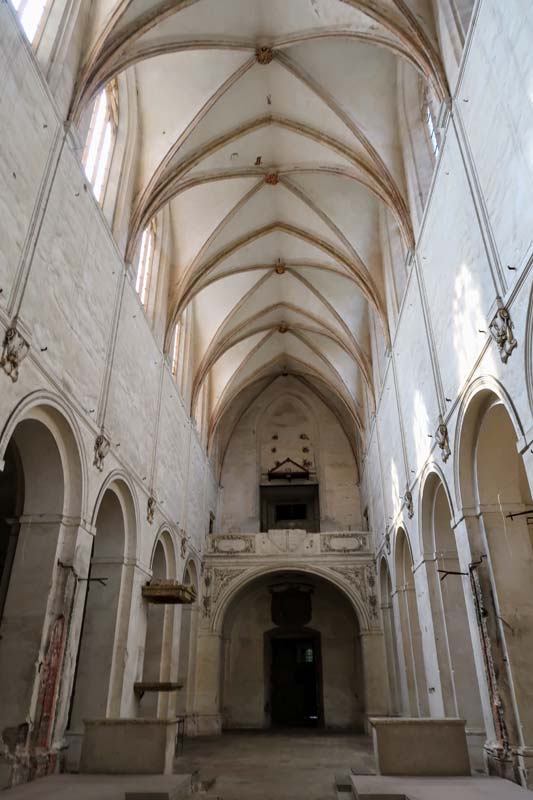
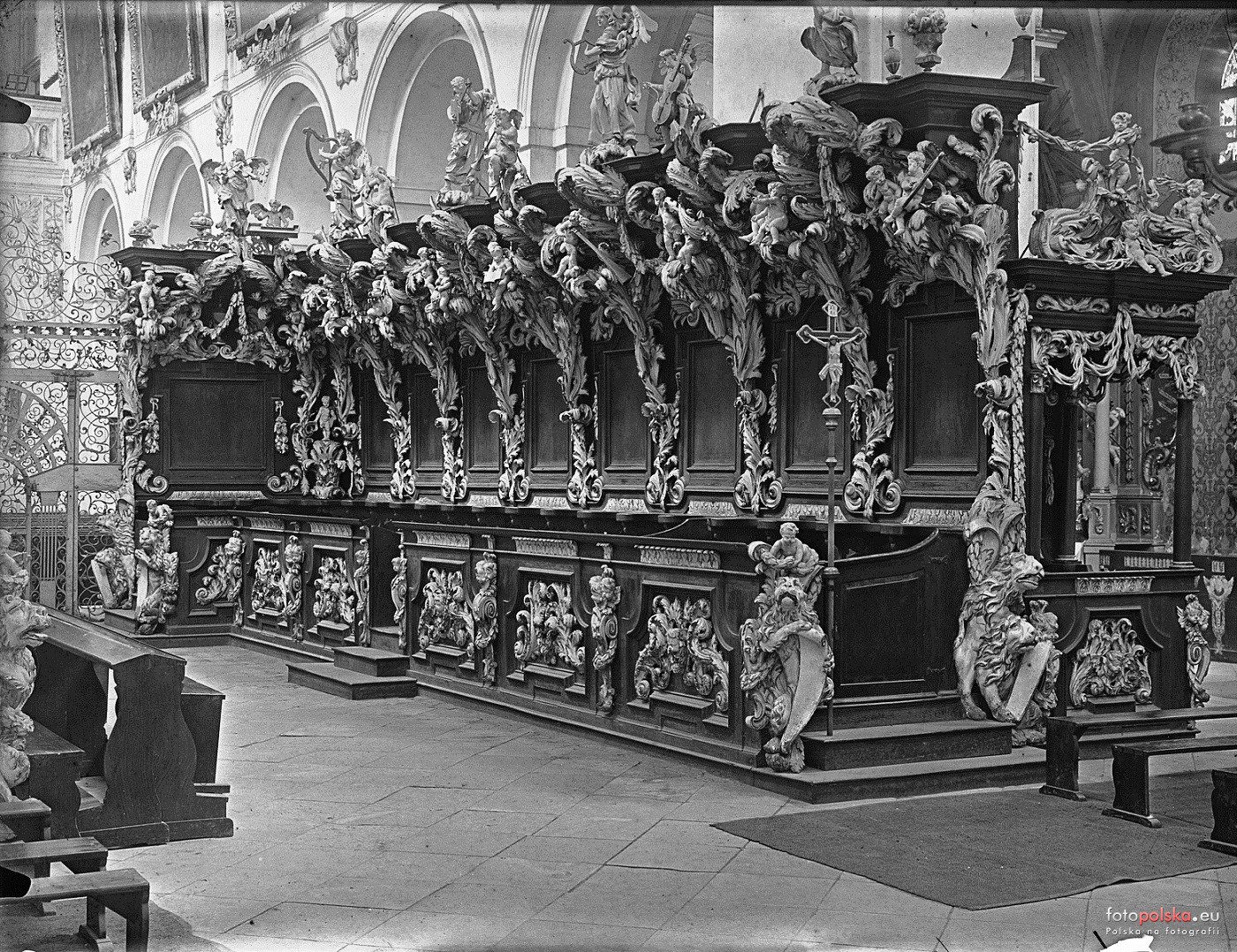
source: fotopolska.eu
7. Church of St. James
It is the oldest building in the entire abbey. I got the impression that it is kept in one piece only by willpower, so it is not open to the public. Large trees grow right next to its facade, which picturesquely surround it with their crowns, but at the same time destabilize its structure, growing into it with roots.
The originally built church on this site was built in 1202, but the building that stands here today dates from 1700. The furnishings were completely destroyed in 1945.
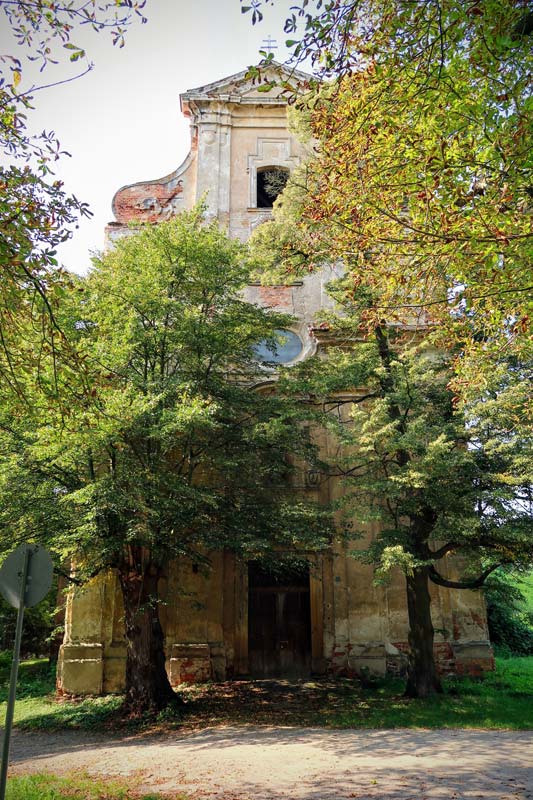
8. Gate
The gate building or simply the main entrance gate to the abbey is a stately building. It was established in 1601 and played a defensive role. Then in 1710 it was expanded and it housed a hospital. The northern facade was restored in 2010.
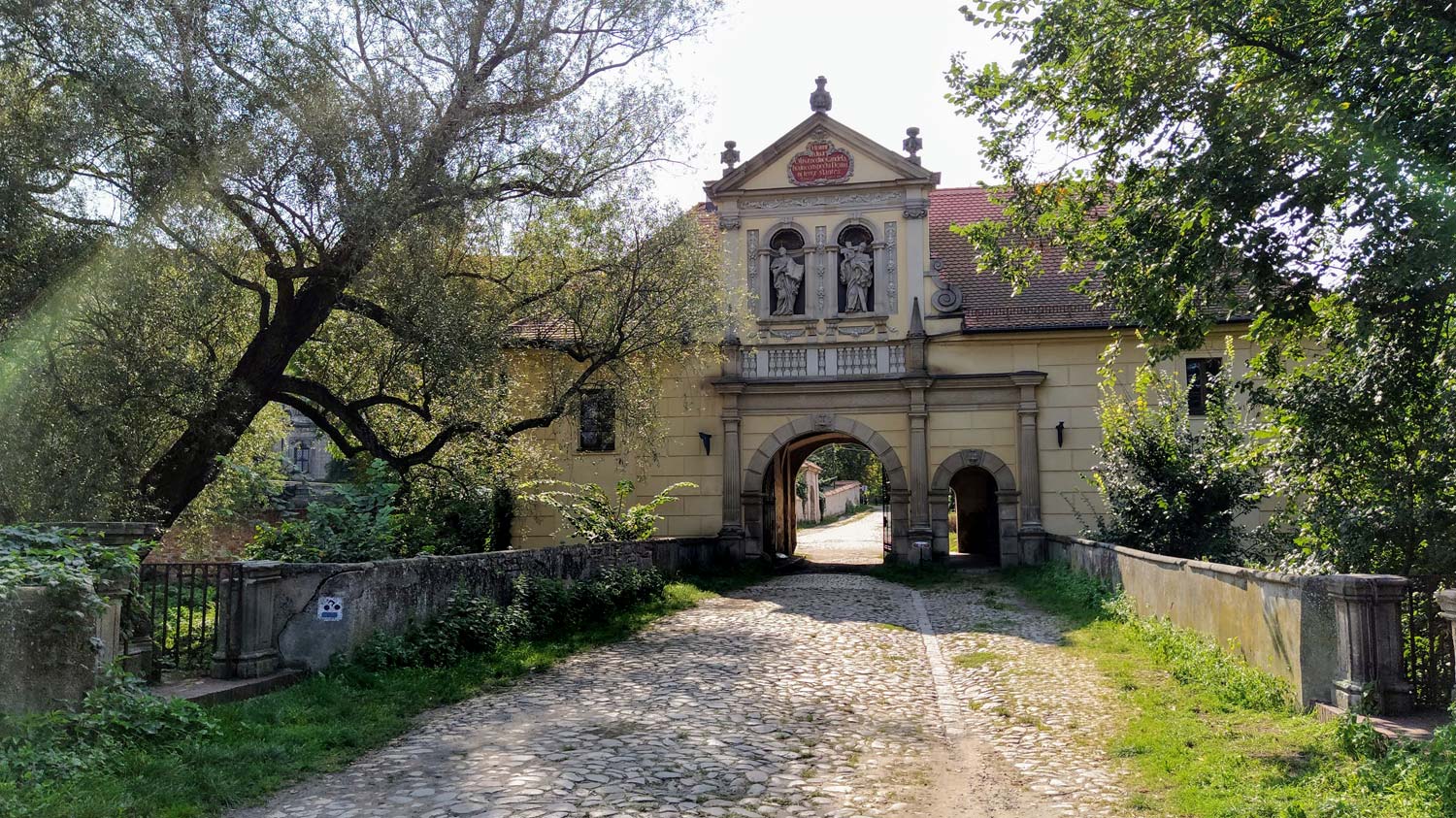
Useful GPS coordinates
Parking at the abbey, GPS coordinates:
51°15’46.8″N 16°28’14.7″E
51.263004, 16.470755 - click and route
If you run out of cash at the cash desk in the abbey (and you can only pay in cash here), you can take it for small purchases at the cash desk in Dino or at a slightly more distant ATM.
Dino Store, GPS coordinates:
51°15’59.0″N 16°28’04.4″E
51.266395, 16.467890 - click and route
ATM at the Lewiatan store, GPS coordinates:
51°16’36.1″N 16°27’29.9″E
51.276681, 16.458294 - click and route
Important to me!
Give the article a good rating (5 stars welcome 😀)!It's free, a for me it is very important! The blog lives on visits and thus has a chance to develop. Please do it and ... thank you in advance!
If you like my guides, you will certainly find the one I created useful guide catalog - [click]. There you will find ready-made ideas for your next trips, descriptions of other tourist destinations and an alphabetical list of guides divided into countries, cities, islands and geographical regions.
I also post link to Facebook profile - [click]. Come in and press "Follow"then you will not miss new, inspiring posts.
Unless you prefer Instagram. I'm not a social media demon, but you can always count on something nice to look at on my instagram profile - [click]. The profile will gladly accept any follower who likes it.
I make the content I create available free of charge with copyright, and the blog survives from advertising and affiliate cooperation. So, automatic ads will be displayed in the content of the articles, and some links are affiliate links. This has no effect on the final price of the service or product, but I may earn a commission for displaying ads or following certain links. I only recommend services and products that I find good and helpful. Since the beginning of the blog's existence, I have not published any sponsored article.
Some of the readers who found the information here very helpful, sometimes ask me how you can support the blog? I do not run fundraisers or support programs (type: patronite, zrzutka or "buy coffee"). The best way is to use links. It costs you nothing, and support for the blog is self-generating.
Pozdrawiam

Excellent reportage. There are plenty of such facilities in Lower Silesia. After all, it is the second cluster of palaces and castles after the Loire Valley. Unfortunately, most often destroyed after the war. A sad testimony of "caring" the Polish state for the historical legacy.
Thank you!
Lower Silesia is an inexhaustible mine of interesting places. I have been under the charm of Lower Silesia for 30 years.
Holy article, I was in Lubiąż a year ago, while reading, I recalled my memories and - interestingly - I want to go back there again. During the holidays - I don't remember when exactly - for one weekend, the majority of the facility is open to the public, to which visitors normally do not have access, it must be great🙂
The history of the abbey dłuuuga and therefore it comes out to recreate the former splendor you would have to put out how much? One hundred million zlotys or more? And keep it all after? This is a renovation for years but I think it's worth it.
Dear Sir, thanks for the beautiful description of a place that is breathtaking ... An amazing place with an amazing history. I've been twice and I'm captivated by this place. But where to get the money for repairs. Perhaps promoting sightseeing will bring a bit of money. I have an idea for the cities that welcome the New Year with tons of fireworks to make a drop on Lubiąż. Maybe it won't work in a pandemic, but you have to try. Requests, advertisements, videos, shows - maybe these are ways for Lubiąż's second life …….
We live in a time of cost optimization, so the maintenance of such facilities does not follow this trend. We live in an era of commercialization and consumption, so it is more profitable to do a fireworks display on New Year's Eve that will be seen by tens of thousands of people than to renovate a facility in the middle of nowhere that few people visit. Such times, such realities.
It is worth going, buying a ticket for PLN 20 and contributing to the modern, very slow but still ascent.
Best wishes!
A wonderful trip, thank you, best regards
Fantastic article 👏 We have just left the Abbey and the content of the article perfectly reflects our impressions.
It is unbelievable that this monument is not protected by the State.
Ps. We found ourselves exploring the attic and cellars.
Very nice article. The only thing that I missed in the history of the facility are the mentions of the SlotART festival, which was held here for several years; I had the opportunity to play with the band in 2011 - admittedly not on the main stage located in the courtyard, but on one of the small "stages" located in the convent's rooms. Unfortunately, the band has not been functioning for a long time, but the memories are unforgettable 🙂
A lot of people remember this party and all of them with nostalgia.
Unfortunately, I did not have a chance to be on SoltART, but let your comment serve as a supplement to this lack in the story I described.
Thank you and best regards!
I would like to thank the author for describing the history of this gem. I hope that such an interesting and beautiful place will be visited by more and more tourists and lovers of Lower Silesia. This article encourages and even mobilizes us to do so.
The pleasure is all mine!
Thank you for the information, it was extremely helpful. Best regards.
Very useful information.
cool. Thanks
I like the article very much. Beautiful photos, a clear plan of the entire facility.
Nice explanation for building an abbey at the intersection of two "rivers".
Unfortunately, the story is sad ...
I am going to visit the abbey on July 8, 2021.
Thanks for the article
Regards Alicja
Thank you very much for the article. I just visited this place with my husband. The building is overwhelming with its size. If it had been completely renovated it would be a haven for the eyes. But we will not live to see it, which is a pity
For a long time I was overwhelmed by the scale of this object and the awareness that its complete renovation is probably impossible ... but in the end positive thinking won, because at least it has a guardian and it does not deteriorate any more.
The object is presented in a fantastic way. A piece of good work, the author! I'm looking for a date and I'm on my way!
The best is in front of you! Have fun exploring!
Great article. Five stars is not enough. It deserves much, much more. I have the opportunity to go there in February. This time of year puts me off. The cold scares me. But after this article, I felt like it. Maybe the desire to see it all live will prevail. Maybe it will warm up.
Best wishes.
It's not far to spring! 👍
Thank you for the wonderful story about the Abbey, it has been our favorite place for walks for several years (we come from Wrocław at any time of the year). In summer, interesting music and ethnographic festivals are held here with a huge number of visitors as well as delicious refreshments in the open air, with music and fairs.
I would like to ask the author of the article if there is any information about unique and interesting old statues at the Cistercian Lubiąż building (4 men and one woman are standing)? One old historian from Warsaw once said that these are statues of people who lived before the flood. Maybe the author knows more about them? Thanks.
And this place is unique, a real "place of power" that fulfills desires.
And one more thing: there is Karchma Cisterska, where the food is very good and tasty, but inexpensive. I recommend!
Karchma Cisterska is located on the premises of the abbey, where the food is very good and tasty, and at the same time inexpensive. I recommend!
Great, detailed article and lots of useful practical information. We are going tomorrow to see for ourselves
Hello Jack!
I don't know which one I have read this article before, but it still amazes me and I love to come back to it.
If you could give 15 stars, that's what I would give.
Until I was overwhelmed ... I don't know what to say. Nice to meet you, thank you!
Mr. Jack,
I heard about the Cistercian Monastery in Lubiąż several times, but there was never an occasion to visit it. I admit that after reading your article, it is our number 1 on the short-vacation route planned soon in the vicinity of the Jizera Mountains.
Thank you very much for the beautiful description, information, and effective encouragement to visit.
Regards,
Jacek
I have a feeling that a nice trip is getting ready 🙂
I wish you beautiful weather!
A very interesting article. 👋 I was there about 15 years ago, but thanks to the information in the article, I organized my knowledge and what I remember from visiting. Thank you 😊
A very carefully prepared text, and at the same time it is read with interest. The facility itself is impressive. The three restored halls give some idea of the appearance of the whole in its heyday. I had the opportunity to see the exhibition on the sugar industry in Lower Silesia and look at the renovation of the main facade. If the monastery does not find a rich sponsor, the renovation will take centuries. Maybe sugar?
Sugar is a thought! 👍
A very good article. I had the opportunity to be there and I visited this object quite thoroughly. The time for renovation (reconstruction) is only possible if there is some way to use it all year round. Considering the isolation of the monastery is quite difficult, but not hopeless. guest is not the so-called Polish state ”ruined the other object, but the war and the Soviet zoldacy. By the way, I can see that it is quite easy for some people in Poland to pee on the legs of Poland. Good luck and many equally interesting trips and reports from them.
A very good article that encourages sightseeing.
Only last weekend I had the opportunity to visit the monastery in Lubiąż - an unforgettable and certainly not the last (to him) trip! An interesting article that allows you to organize the information you hear and read! Cheers!
Congratulations on the text.
I had the opportunity to visit the buildings at the turn of the century, when work was still underway in the prince's hall, and later in 2000 or 2001, to admire the work of the restorers in the abbot's dining room from the scaffoldings under the very ceiling. In the church and other halls there was still a "mess" from the time of the pro-Russian "occupation" of the monastery.
Feelings indescribable.
This complex is one of those (and the above report) that arouse reflection on the volatility of the fate of people and buildings under the influence of "the winds of history.
I would like to thank the author for a pretext to remind me of my stay in Lubiąż.